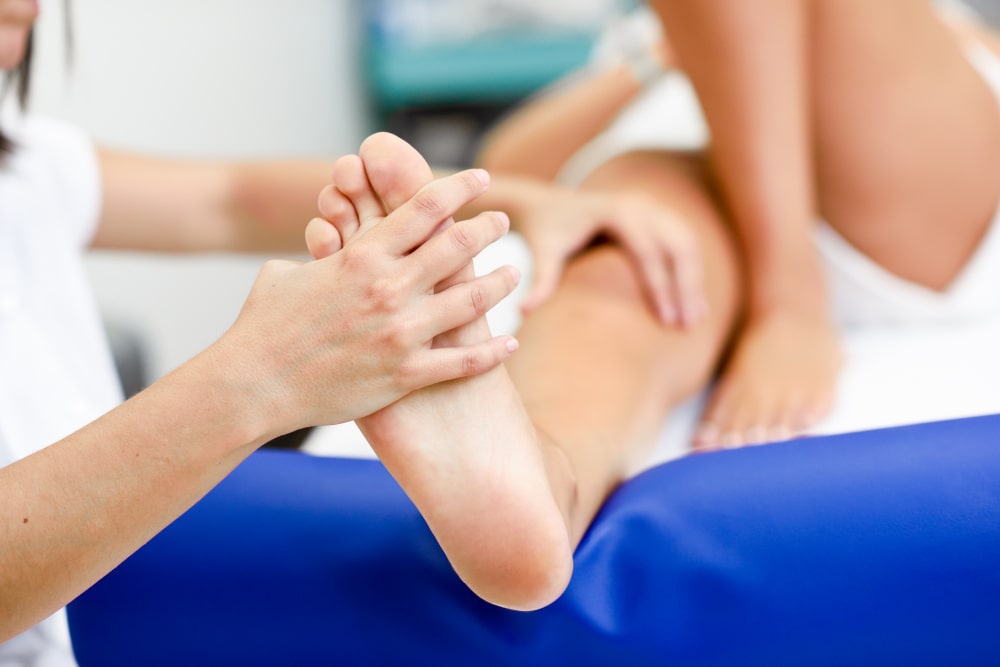Navicular bone pain is a common condition caused by inflammation and injury to the navicular bone near your foot’s arch. This type of pain can range from mild to severe, depending on the cause, and might require professional treatment in some cases. This article will discuss what causes navicular bone pain, its symptoms, diagnosis, treatment options, prevention strategies, and more.
Understanding the Navicular Bone
The navicular bone is a small bone in the center of your foot near the arch. It serves as an important weight-bearing joint by helping to protect and support your foot when you walk or run. The navicular bone connects with two of your other foot bones, the talus, and cuboid, forming a triangle that helps to stabilize your foot.
Read More: Yeast Infection While on Period: What Causes It, How to Treat It?
Causes of Navicular Bone Pain
There are several potential causes of navicular bone pain. These include:
- Overuse and Repetitive Strain: Prolonged activities such as running or jumping can cause wear and tear on the navicular bone, leading to pain and inflammation.
- Trauma or Injury: Damage to the navicular bone caused by direct trauma such as a fall, sprain, fracture, dislocation, or any other type of physical injury can lead to pain in this area.
- Structural Abnormalities: Some people may have structural abnormalities in their feet, which can cause the navicular bone to be compressed or stretched, resulting in ache.
- Inflammatory Conditions: Certain inflammatory conditions, such as gout and rheumatoid arthritis, can lead to navicular bone pain.
- Arthritis: Foot osteoarthritis is a major cause of navicular bone pain. This condition occurs when the cartilage between the bones of the foot wears down, causing inflammation and pain.
Symptoms of Navicular Bone Pain
The most common symptom of navicular bone pain is a dull or sharp ache in the middle of your arch that intensifies when you move or put weight on your foot. Other signs and symptoms include swelling, tenderness, redness, stiffness, difficulty walking or standing for long periods, and a burning sensation in the arch of your foot.

Read More: Foot Pain After Running: Causes, 7 Effective Treatments
Diagnosing Navicular Bone Pain
To diagnose navicular bone pain correctly, your doctor will take into account a variety of factors, such as your medical history, physical exam findings, and imaging tests.
Physical Examination: Your doctor will perform a physical examination of your foot. They may press on the navicular bone to assess for tenderness or swelling and check for any signs of injury.
Imaging Tests: X-rays or MRI scans may be used to assess the condition of your foot and identify any structural abnormalities or other causes of your pain.
Diagnostic Injections: If the cause of your pain is unclear, a diagnostic injection of a numbing agent may determine which area is causing your pain.
Read More: Pain Behind Knee Hamstring: Causes, Symptoms, Treatment
Treatment Options for Navicular Bone Pain
Treatment for navicular bone pain depends on the cause and severity of your condition. Rest and activity modification alone may be enough to reduce your symptoms. Other treatment options include physical therapy, medications, orthotic devices, injections, and surgery.
- Rest and Activity Modification: It is important to rest your foot and limit activities that put a strain on the navicular bone. This may include avoiding high-impact activities such as running or jumping and wearing supportive shoes when walking or standing for long periods of time.
- Physical Therapy: A physical therapist can help you develop exercises to strengthen your foot muscles and improve flexibility in the joint, which can reduce pain and inflammation.
- Medications: Nonsteroidal anti-inflammatory drugs (NSAIDs) such as ibuprofen or naproxen may be prescribed to reduce pain and inflammation.
- Orthotic Devices: Shoe inserts can help support your foot and provide cushioning when walking or running, reducing the strain on the navicular bone.
- Injections: Your doctor may recommend a corticosteroid injection to reduce inflammation and provide short-term relief from pain.
- Surgery: In some cases, surgery may be necessary to repair or reconstruct the navicular bone if it is damaged due to injury or arthritis.

Read More: Groin Pain When Walking: What Causes It, How to Treat It?
Prevention and Self-Care Tips
To reduce your risk of navicular bone pain, taking preventive measures such as wearing proper footwear and maintaining a healthy weight is important. You should also warm up and stretch before any physical activity and perform strengthening exercises to keep the muscles in your foot strong.
Proper Footwear: Shoes that provide ample cushioning and arch support can help reduce the strain on your navicular bone.
Healthy Weight: Being overweight or obese can increase the risk of navicular bone pain, so it is important to maintain a healthy weight.
Warm-up and Stretching: Warming up before any activity can help reduce the risk of injury and pain.
Strengthening Exercises: Regularly performing strengthening exercises can help keep the muscles in your foot strong and support the navicular bone.
Navicular bone pain is common and can cause various symptoms, from mild discomfort to severe pain. If you are experiencing this type of pain, it is important to speak with your doctor to determine the underlying cause and develop a treatment plan.
Read More: Nerve Pain in Shoulder: What Causes It, How to Treat It?
Stretching Exercise for navicular bone pain Relief
To help manage and prevent navicular bone pain, it is important to adopt a regular exercise routine that includes stretching and strengthening exercises. Here are some specific exercises and stretches that you can do:
- Towel Stretch: This move helps stretch the arch of your foot and strengthen the tendons and muscles in your foot and lower leg. Sit on the floor with your legs stretched out before you do this stretch. Place a towel around the bottom of one foot to pull your toes toward you until you feel a gentle stretch in your arch. Hold for 10-15 seconds and repeat two to three times on each foot.
- Calf Stretch: This move helps stretch the calf muscles and the foot arch. To do this stretch, stand with your feet hip-width apart and place a rolled-up towel or ball beneath the arch of one foot. Lean forward onto your toes until you feel a gentle stretch in your calf muscles, and hold for 10-15 seconds before repeating on the other side.
- Toe Lifts: This exercise helps strengthen the muscles in your feet, which can help reduce navicular bone pain. To do this exercise, sit on the floor and place a rolled-up towel or ball beneath the arch of one foot. Curl your toes around the towel, lift it off the ground as far as possible, then slowly lower it back down. Repeat 10-15 times on each foot.
By incorporating these exercises and stretches into your daily routine, you can help manage the symptoms of navicular bone ache and prevent further injury or discomfort. Be sure to speak with a doctor or physical therapist for guidance on how to perform these exercises correctly and safely.

Read More: Can a Sinus Infection Make You Dizzy? A Complete Guideness
Conclusion
Navicular bone pain is a common condition that can cause mild to severe discomfort. Treatment usually involves rest, activity modification, physical therapy, medications, orthotic devices, injections, and in some cases, surgery. It is important to adopt a regular exercise routine that includes stretching and strengthening exercises to prevent further injury or discomfort. Following the tips in this article can help reduce your risk of navicular bone ache and manage your symptoms. If you are experiencing pain or discomfort in the navicular area, speak with a doctor for further guidance on treatment options and self-care strategies.
FAQs
Yes, rest and activity modification may be enough to reduce your symptoms. However, if the pain persists or worsens, it is important to speak with a doctor for further treatment options.
No, not necessarily. Rest, physical therapy, and medications may be enough to reduce your symptoms. Surgery is usually only recommended if the navicular bone is damaged due to injury or arthritis.
Exercises such as toe lifts, calf stretches, and towel stretches can help stretch and strengthen the muscles in your feet, which can reduce pain and inflammation. Be sure to speak with a doctor or physical therapist for guidance on how to perform these exercises correctly and safely.
Shoes that provide ample cushioning and arch support are recommended to reduce navicular bone strain. It is also important to ensure the shoes fit properly and are not too tight or loose.
Yes, maintaining a healthy weight can reduce the strain on your feet and help manage symptoms of navicular bone pain. If you are overweight or obese, speak with a doctor about ways to safely and effectively lose weight.

